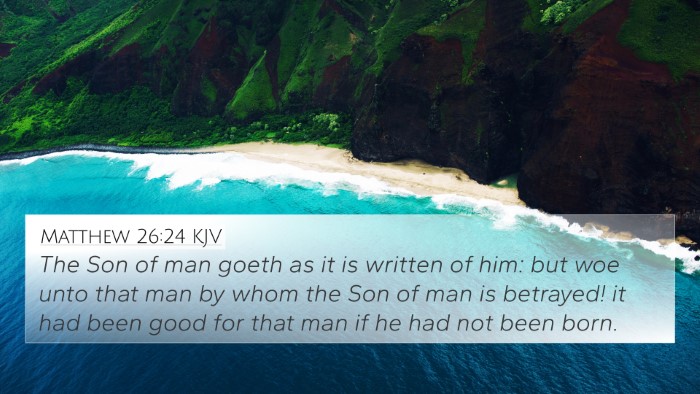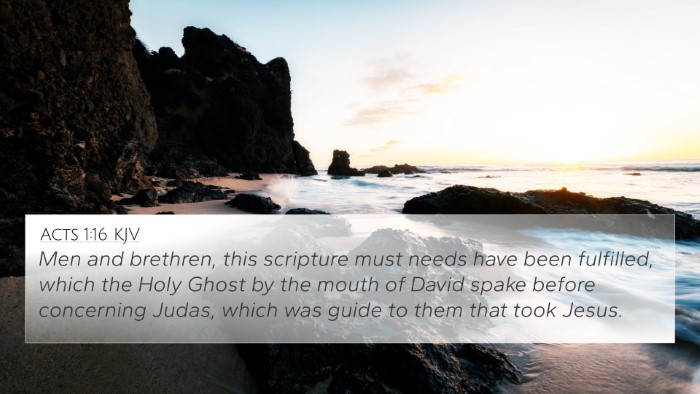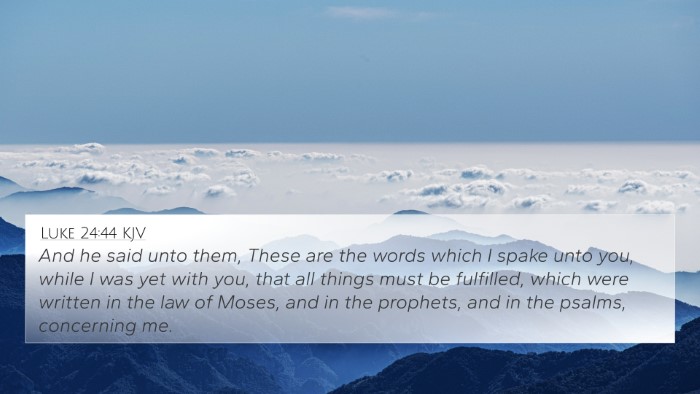Bible Verse Analysis: Matthew 26:54
Verse Reference: Matthew 26:54
"But how then shall the scriptures be fulfilled, that thus it must be?"
Overview
This verse occurs during the arrest of Jesus in the Garden of Gethsemane. It is spoken by Jesus in response to Peter's impulsive action of cutting off the ear of one of the high priest’s servants. Jesus is indicating that his arrest is essential for the fulfillment of the Scriptures, which foretold his suffering and death.
Commentary Insights
Insights from public domain commentaries shed light on several dimensions of this verse:
- Matthew Henry: This commentary emphasizes the necessity of the prophetic scriptures being fulfilled. Henry notes that the events leading to Jesus' crucifixion were not arbitrary but divinely ordained to demonstrate God's sovereignty and fulfill His redemptive plan.
- Albert Barnes: Barnes discusses the implications of Jesus’ submission to the will of God. He articulates that Jesus was aware of the prophecies and the role He was to play, thus portraying a profound commitment to the scriptures which predicted His suffering.
- Adam Clarke: Clarke elaborates on the theological significance of the phrase "that thus it must be." He suggests that this indicates necessity in God's plan, showing that Jesus willingly embraces His destiny as part of His divine mission for humanity's redemption.
Inter-Biblical Connections
Matthew 26:54 can be cross-referenced with various scriptures throughout the Bible, illustrating thematic connections:
- Isaiah 53:3-5: Foretells the suffering servant who will bear the sins of many.
- Psalms 22: Describes the suffering of the righteous and prophetic details related to Christ's crucifixion.
- Zechariah 13:7: Speaks of the shepherd being struck, aligning with the New Testament narrative of Jesus' arrest.
- Luke 24:25-27: Jesus explains to the disciples how the scriptures pointed to Him, making connections to the suffering described in the Old Testament.
- John 12:27-28: Here, Jesus acknowledges His distress about facing death and submits Himself to the Father's will, highlighting His commitment to fulfilling scriptural prophesies.
- Acts 3:18: Explains that God foretold the suffering of Christ through the prophets, underscoring the fulfillment aspect of His mission.
- 1 Peter 1:10-11: Imparts that the prophets spoke of the grace destined for believers, revealing the significance of Christ’s sufferings.
- Romans 1:2: States that the Gospel had been promised beforehand through the prophets, directly connecting to the necessity of fulfillment in Christ’s life.
- Mark 14:49: Jesus refers to the prophecies being fulfilled, reinforcing the necessity of events as ordained in scripture.
- Hebrews 10:7: Presents Christ as coming to do the Father’s will, indicating His deliberate action toward fulfilling Divine prophecy.
Theological Reflections
Matthew 26:54 offers profound insights into the nature of Christ's mission and the fulfillment of God's will. The analysis underscores several key themes:
- Divine Sovereignty: The preordained nature of Jesus' suffering shows God's control over redemptive history.
- Fulfillment of Prophecy: Jesus’ awareness and acceptance of prophetic scriptures emphasize the significance of the Old Testament in the New Testament context.
- Human Reaction: Peter’s violence represents the human inclination to react in self-preservation, contrasting with Christ's peaceful submission.
- Call to Trust: This verse challenges believers to trust in God's plan even in times of distress or uncertainty:
Conclusion
Matthew 26:54 invites reflection on the importance of recognizing and understanding the interconnectedness of biblical truths. The seamless narrative from the Old Testament to the New Testament illustrates the significance of cross-referencing biblical texts. Engaging in comparative Bible verse analysis using tools like a Bible concordance or a cross-reference Bible study can deepen one's understanding of scripture.
Further Exploration
For those keen on exploring the connections between Bible verses and understanding their meanings more profoundly, consider:
- Using Bible concordance to identify key themes.
- Employing a cross-reference Bible study guide for thematic investigations.
- Looking into detailed cross-references between Gospels for cohesive understanding.
- Examining how specific verses relate to larger gospel themes of redemption and prophecy.
Key Takeaways
- Matthew 26:54 highlights the necessary fulfillment of scriptures.
- Understanding this fulfillment can enrich faith and comprehension of God's plan.
- Cross-referencing biblical texts can significantly enhance the study and interpretation of scripture.












